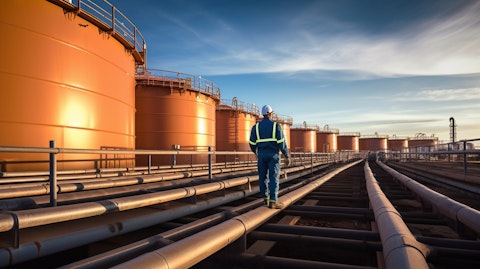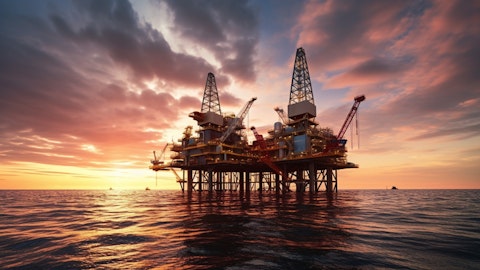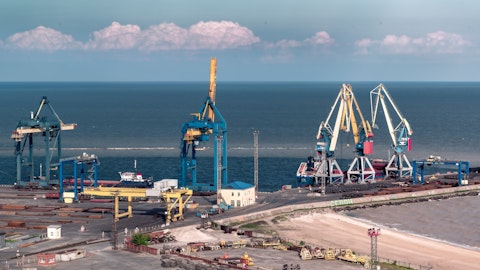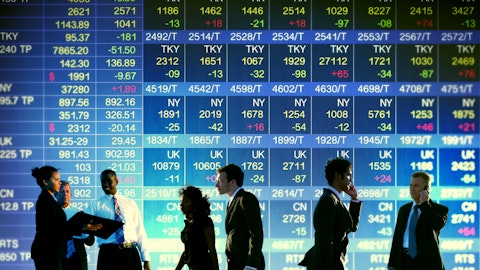Diamondback Energy, Inc. (NASDAQ:FANG) Q3 2023 Earnings Call Transcript November 7, 2023
Operator: Good day, and thank you for standing by. Welcome to the Diamondback Energy Third Quarter 2023 Earnings Conference Call. At this time, all participants are in a listen-only mode. After the speaker’s presentation, there will be a question-and-answer session. [Operator Instructions] Please be advised that today’s conference is being recorded. I would now like to hand the conference over to your first speaker today, Adam Lawlis, VP of Investor Relations. Please go ahead.
Adam Lawlis: Thank you, Steven. Good morning, and welcome to Diamondback Energy’s third quarter 2023 conference call. During our call today, we will reference an updated investor presentation and Letter to Stockholders, which can be found on Diamondback’s website. Representing Diamondback today are Travis Stice, Chairman and CEO; Kaes Van’t Hof, President and CFO; and Danny Wesson, COO. During this conference call, the participants may make certain forward-looking statements relating to the Company’s financial condition, results of operations, plans, objectives, future performance and businesses. We caution you that actual results could differ materially from those that are indicated in these forward-looking statements due to a variety of factors.

Information concerning these factors can be found in Company’s filings with the SEC. In addition, we will make reference to certain non-GAAP measures. The reconciliations with the appropriate GAAP measures can be found in our earnings release issued yesterday afternoon. I’ll now turn the call over to Travis Stice.
Travis D. Stice: Thank you, Adam, and good morning to everyone. As Adam mentioned, we released a Shareholder Letter last night that contains much of the narrative we hope to cover again this morning. So with that, we’ll just open the lines up for question. Operator?
See also 11 Best Transportation Stocks To Buy Heading Into 2024 and 20 Best Online Jewelry Stores In the World.
Q&A Session
Follow Diamondback Energy Inc. (NASDAQ:FANG)
Follow Diamondback Energy Inc. (NASDAQ:FANG)
Operator: Alright. Thank you. At this time, we will conduct a question-and-answer session. [Operator Instructions] Our first question comes from the line of Neal Dingmann of Truist Securities. Please go ahead.
Neal Dingmann: Morning, Travis and team. Thanks for the time and another nice quarter. Travis, my first question is on capital allocation specifically. Several quarters ago, you suggested you all would return to more of a production growth type model, I’d call it. And I think you’ve mentioned when the macro fundamental supported. I’m just wondering, do you believe we’re close to that scenario and wondering, why do you believe the continued high free cash flow payout is warranted?
Travis D. Stice: Yes. Neal, that’s a good question. Look, the world is certainly in a mess right now across any number of fronts. All of which could potentially move the markets both positively and negatively, both with the supply disruption or even a demand destruction as well too. So, obviously, we can’t control any of those items. Again, we simply respond to our shareholders that own our company. That right now return a shareholder model versus a growth model, as we’ve intimated our plans as we look forward into next year again, look for real efficient capital allocation and as an output of that capital allocation which expect low-single-digit type volume growth. Again, not as an input, but what results from an efficient capital allocation program.
Neal Dingmann: Got it. That makes sense in this environment. And then secondly on your development, couldn’t help but notice the new slides on slides 10 and 11 highlighted the efficient execution and then, differentiated development. My question is, does most of your remaining Midland inventory lend to the 24 average, wells per project size that you mentioned. And then I’m just wondering, could you speak to where the largest cost efficiencies continue to come from on these projects?
Travis D. Stice: Sure. On the development strategy, over time slide, which is slide 11 for those of you that are looking at it online. We tried to demonstrate our evolution from 2015 to today, and we said average wells per project is about 24 wells. I think generally that applies across our Midland Basin. However, not all deposits are equal in terms of the way the shale were laid down across the Midland Basin. So, there will be areas where we can do slightly more than 24 wells, and then areas also where we’ll do slightly less than 24 wells, which usually translates to one or two wells less per shale interval. So again, it’s a general representation showing the development over time. But that’s a good that’s a good summary. And then, let’s see. What was your second question?
Neal Dingmann: Just on the cost, on the cost, I know, Kaes and I’ve talked about, I mean, is it just on, I know you have lower casing just different, sort of raw material costs, but is there, is there other, areas in that that larger projects that are causing these, when you see that, that well productivity chart on the right, sort of what’s driving the lower cost efficiencies there?
Travis D. Stice: Yes, certainly. Again, referencing back to slide 10, we’ve laid out the biggest elements of cost savings, cost components, and the reductions over time. And again, as you pointed out, it’s casing to down 20% or so. It’s really, as you look into next year, we feel more of a kind of a steady state run rate on our cost. There’ll be some puts and takes on both sides of the equation. Kaes, do you want to add anything?
Kaes Van’t Hof: Yes. I mean, I think the biggest benefit to the large scale development, Neal, is the consistency of running the rigs in the same spot for a long period of time. But, on the frac side is where we save the most money from a capital perspective, because we’re doing — in some cases, two SimulFRAC crews on the same site at the same time. So, you’re saving essentially, $250,000 – $300,000 a well from SimulFRAC. And now we have two of those fleets or e-fleets that run-off lean gas that save kind of another $200,000 – $250,000 of well. So, now this large scale development kind of ties to the longer cycle nature of our business, and that also means we don’t want to change the plan every move in oil price. And so, we’ve had a consistent plan here for a few years now, and the output of that is consistent results on the well productivity per foot.
Neal Dingmann: Thank you both.
Travis D. Stice: Thanks, Neal.
Operator: Thank you. One moment for our next question. Our next question comes from the line of Neil Mehta of Goldman Sachs & Co. Your line is open.
Neil Mehta: Yes. Thanks, guys, and appreciate the helpful letter and the time today. Travis, why don’t we start on return of capital as a topic talked about this in the letter of, you wanting to air on the side of caution as it relates to, buying back stock to avoid repurchasing pro-cyclically and as a result, leaned into the variable dividend in the last quarter. Can you talk about, the way that you’re approaching this and how that should inform the way we think about, the split between buybacks and dividends going forward?
Travis D. Stice: So, Neil, our main focus remains a sustainable in growing base dividend that we think represents the most efficient way for our shareholders to understand what our shareholder return program looks like. Following that is the share repurchase program, which we laid out the — what we’ve done in the third quarter in so far in the fourth quarter. And then we honor our commitment to return at least 75% of our free cash flow by making our shareholders hold in the form of variable, which we’ve seen we did this year. I think the most important thing is when you talk about share repurchases is that you need to have some discipline around that because in my experience, lack of discipline leads to chasing stock repurchases all the way to the top of the cycle.
So, we like most of our capital allocation decisions, actually like all of our capital allocation decisions, we hold ourselves accountable to some form of rigorous analytics, and in this case, we continue to run a NAV value at mid cycle oil prices, which is $60 oil, and calculate oil price or calculate stock price, and depending on where our stock is trading relative to that calculation, we either buy more of in the further dislocation we get from that, we buy, we increase or if not then we pivot to a share repurchase — or to a variable dividend like we did this time around. So, again, it just it’s based dividend. Its share repurchases with a degree of caution in a pro-cyclical environment and then honoring our commitment to the form of a variable dividend.
Neil Mehta: Okay. That, that’s really helpful. And the follow-up is just on non-core asset sales. You’ve done a good job of exceeding your target. Can you talk a little bit about the Deep Blue Midland Basin and JV, and then not only in terms of the proceeds, but what does it mean for your go-forward cost structure, as we think about modeling the impacts through 2024?




